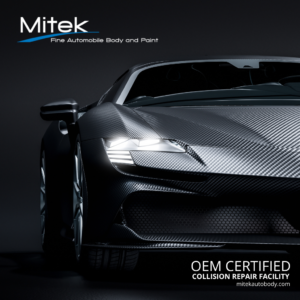Maintaining Your Luxury Car’s Value After a Collision
No matter where you live or what kind of car you drive, being involved in a collision is a terrible experience. For owners of luxury cars, it can be extra harrowing.
For those who have a passion and appreciation for them, luxury cars are worth every penny. There are not many downsides to owning the car of your dreams, unless you get involved in an accident. It’s bad enough to see your cherished ride sustain damage, but the specter of “diminished value” can take your pain to the next level. This is one phrase that you definitely never want to hear uttered in reference to your pride and joy.
In this blog, we’re going to explain what “diminished value” means, and how this dreaded term could impact you financially in the event that your dream car sustains damage due to a collision.
What is “Diminished Value”?
In the broadest terms, “diminished value” refers to the fact that buyers are often more reluctant (or may even refuse) to buy a vehicle that has sustained damage in a collision, no matter how flawlessly it’s been repaired.
Technically, there are three sub-types of diminished value:
Inherent Diminished Value: The loss of value that occurs simply by virtue of the fact that the car has sustained collision-related damage, and regardless of the fact it’s been repaired.
Immediate Diminished Value: This refers to the decrease in value that happens the moment the car sustains damage, before any collision repairs have even been attempted
Repair-Related Diminished Value: This is the loss of value that can occur as a result of sub-par repairs and/or the use of non-OEM parts in completing repairs.
Why Does Diminished Value Hit Luxury Cars Harder?
Unfortunately, the more valuable and coveted a car is, the more drastically its value can fall after an accident. Compared to “regular” cars, high-end vehicles can undergo a much more dramatic drop in value after they’ve been damaged, even though they may have received the most costly and expert collision repair service available.
Luxury cars are intended and designed to provide unrivaled luxury, performance and comfort. These qualities that make them so desirable to begin with can also make them more susceptible to diminished value after an accident. There are three main reasons for this:
Buyers Expect the Best: Let’s face it, when buyers dig out big bucks for luxury cars, they expect perfection (or as close as possible to it). When a high-end car has been damaged, even to a lesser degree, its value can be impacted dramatically.
Expensive Components and Materials: Luxury cars are manufactured using costly refined materials and cutting-edge technologies. Repairing them is also costly and demands specialized knowledge, yet future potential buyers may never feel confident that the vehicle has been successfully restored to its former appearance and performance.
The Image Factor: Luxury cars are renowned for projecting an image of opulence and perfection. When damage occurs, this image is tarnished, and the vehicle becomes less desirable to potential future buyers.
How is Diminished Value Determined?
There are several factors that influence the extent of diminished value in luxury cars. These include the degree of damage sustained and the quality of the collision repairs (i.e. whether OEM parts were used), as well as the age, mileage and market demand of the vehicle.
Many insurance companies use a standard calculation to determine the value of a vehicle after it’s been in an accident (the 17C Formula), as explained in detail in this blog. There are also online calculators that can help you determine how much your car’s value may have dropped.
However, it’s important to note that diminished value is not a loss that is covered by Canadian insurance providers. In other words, the only possible way for you to recoup a significant loss of vehicle value would be to battle it out in court with your own insurance provider or the at-fault driver’s provider.
What You Can Do to Protect Your Investment
The only surefire way to prevent the value of your vehicle from diminishing after an accident is to never drive it anywhere, but that’s no fun! So, what can you do? In addition to keeping detailed records of your car’s condition, maintenance and repairs, our best advice is to ensure that necessary repairs are always completed by a highly reputable provider that’s committed to using OEM parts.
At Mitek, we’re an OEM certified collision repair facility for more than a dozen high-end manufacturers, and over 2,000 luxury vehicle owners (aka fanatics) trust us with their repairs each year. We can’t guarantee the value of your luxury car will not take a hit if it should ever be involved in a collision, but you can rest assured that we’ll use all of our considerable knowledge and skills to ensure it retains as much of its value as possible.

